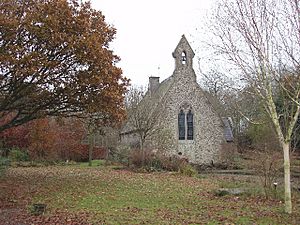All Saints' Church, Manningford Bohune facts for kids
Quick facts for kids All Saints' Church |
|
|---|---|
 |
|
| Religion | |
| Affiliation | Church of England |
| Ecclesiastical or organizational status | Closed |
| Year consecrated | 1859 |
| Location | |
| Location | Manningford Bohune, Wiltshire, England |
| Architecture | |
| Architect(s) | Whitley C. Clacy |
| Architectural type | Church |
| Architectural style | Early English |
All Saints' Church is a building in Manningford Bohune, Wiltshire, England, that used to be a Church of England church. It was designed by an architect named Whitley C. Clacy and built between 1858 and 1859. The church was officially closed in 1973 and was later sold in 1975. Today, it is a private home. Since 1952, it has been recognized as a Grade II listed building, which means it's an important historical building.
Contents
History of All Saints' Church
All Saints' Church was built as a "chapel of ease." This means it was a smaller church built to help people who lived far away from the main parish church, which in this case was St Nicholas in Wilsford. In 1857, people suggested building a church in Manningford Bohune because many residents had to travel two to three miles to reach their parish church. Also, the village's population had grown.
Funding and Construction
A piece of land for the church was given by Mr. Henry Jenner. Money for building the church came from donations and grants. Rev. George Ernest Howman, who was in charge of the church's finances, gave £700. Rev. W. T. Wyld donated £155 and helped raise another £245. The Incorporated Society gave a grant of £110, and the Diocesan Society gave £100.
Whitley C. Clacy from Devizes drew up the plans for the church. The builders, Messrs. May and Sons from Bath, were hired, and the architect oversaw the construction. Mrs. Howman laid the first stone, called the foundation stone, on May 14, 1858. During construction, they found they had to dig the foundations deeper than expected, which cost extra money.
Completion and Consecration
The church cost £1,350 to build and was finished on October 1, 1858. It was supposed to be officially dedicated, or "consecrated," on November 1 (All Saints' Day). However, this was delayed because the Bishop of Salisbury wanted the church to be able to hold two services every Sunday. The Bishop of Salisbury, the Right Rev. Walter Kerr Hamilton, finally consecrated the church on March 1, 1859. This ceremony officially set the building aside for religious use.
Changes and Closure
In 1924, the church and some of the surrounding area were moved from the Wilsford parish to the Woodborough parish. This created a new combined parish called Woodborough with Manningford Bohune.
On April 3, 1973, the Church of England declared All Saints' Church "redundant," meaning it was no longer needed for church services. It was then sold in 1975 and changed into a private home.
Architecture of the Church
All Saints' Church was built using Twerton blue lias stone, which is a type of rock, held together with grey mortar. It has decorative parts made of freestone and a slate roof. The church building included a nave (the main part where people sit), a chancel (the area near the altar), a south porch (an entrance), and a north vestry (a room for the clergy).
A bellcote, which is a small structure holding a single bell, was placed on the west end of the church. A stone cross was on the east end. Inside, the open roof was made of stained wood. The original church furniture included benches made of stained wood, a stone font (for baptisms), a stone pulpit (where sermons are given), and an oak prayer desk. The floor was covered with black and red tiles. Rev. Howman gave the beautiful stained glass windows for the east and west ends of the church.

